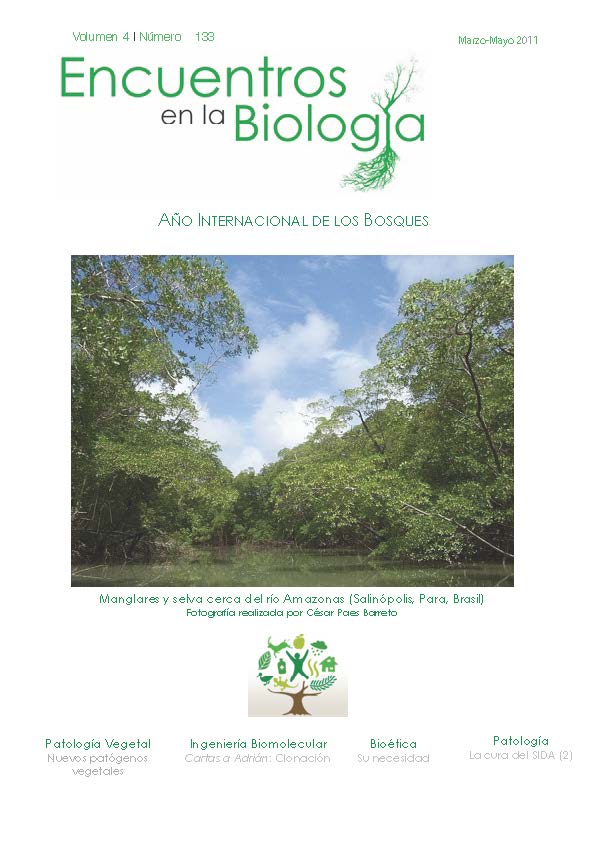New plant pathogens: Emerged from nowhere?
Keywords:
new pathogens, plantsAbstract
When a new pathogenic organism appears that causes serious losses in some plant crop, it is very common to use that term, appear, as if it had emerged from nowhere. The theory of spontaneous generation, now totally falsified, is far behind in time. Therefore, one of the interesting aspects in the evolutionary study of the emergence of plant pathogenic organisms in agricultural ecosystems is trying to answer questions of the type, where, when and how a certain pathogenic organism emerged. The very nature of the agricultural ecosystem has played a significant role in the emergence and expansion of plant pathogens
Downloads
Metrics
Publication Facts
Reviewer profiles N/A
Author statements
Indexed in
-
—
- Academic society
- N/A
- Publisher
- Uma Editorial. Universidad de Málaga
References
Balter M. Seeking agriculture's ancient roots. Science 316: 1830-1835, 2007.
S. McDonald BA. Migration patterns among global populations of the pathogenic fungus Mycospaherella graminicola. Mol Ecol.14:
-1896, 2005.
Godwin SB, Cohen BA, Fry WE. Panglobal distribution of a single clonal lineage of the Irish potato famine fungus. Proc Natl Acad
Sci USA 91: 11591-11595, 1994.
Spatafora JW. Sung GH, Sung JM, Hywel-Jones NL, White JF. Phylogenetic evidence for en animal pathogen origin of ergot and the
grass endophytes. Mol Ecol 16: 1701-1711, 2007.
Stukenbrock EH, McDonald BM. The origins of plant pathogens in agro-ecosystems. Annu Rev Phytopathol 46: 75-100, 2008.
van der Does HC, Rep M. Virulence genes and the evolution of host speci!city in plant pathogen fungi. Mol Plant-Microbe Interact
:1175-1182, 2007
Downloads
Published
How to Cite
Issue
Section
License
Esta obra está bajo licencia internacional Creative Commons Reconocimiento-NoComercial-CompartirIgual 4.0.
Esta revista provee acceso libre inmediato a su contenido bajo el principio de hacer disponible gratuitamente la investigación al público. Todos los contenidos publicados en Encuentros en la Bilogía están sujetos a la licencia Creative Commons Reconocimento-NoComercia-Compartirigual 4.0 cuyo texto completo puede consultar en <http://creativecommons.org/licenses/by-nc-sa/4.0>
Se pueden copiar, usar, difundir, transmitir y exponer públicamente, siempre que:
Se cite la autoría y la fuente original de su publicación (revista, editorial y URL de la obra).
No se usen para fines comerciales.
Se mencione la existencia y especificaciones de esta licencia de uso
Los derechos de autor son de dos clases: morales y patrimoniales. Los derechos morales son prerrogativas perpetuas, irrenunciables, intransferibles, inalienables, inembargables e imprescriptibles. De acuerdo con la legislación de derechos de autor, Encuentros en la Biología reconoce y respeta el derecho moral de los autores/as, así como la titularidad del derecho patrimonial, el cual será cedido a la Universidad de Málaga para su difusión en acceso abierto. Los derechos patrimoniales, se refieren a los beneficios que se obtienen por el uso o divulgación de las obras. Encuentros en la Biología se publica en open access y queda autorizada en exclusiva para realizar o autorizar por cualquier medio el uso, distribución, divulgación, reproducción, adaptación, traducción o transformación de la obra.
Es responsabilidad de los autores/as obtener los permisos necesarios de las imágenes que están sujetas a derechos de autor.
Los autores/as cuyas contribuciones sean aceptadas para su publicación en esta revista conservarán el derecho no exclusivo de utilizar sus contribuciones con fines académicos, de investigación y educativos, incluyendo el auto-archivo o depósito en repositorios de acceso abierto de cualquier tipo.
La edición electrónica de esta revista esta editada por la Editorial de la Universidad de Málaga (UmaEditorial), siendo necesario citar la procedencia en cualquier reproducción parcial o total.


